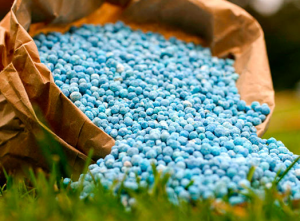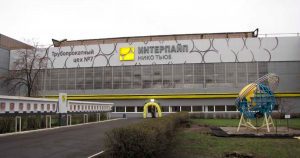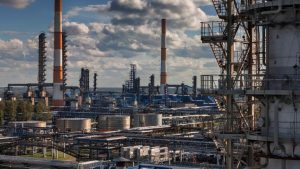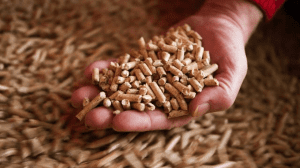
PrJSC Severodonetsk Azot (Luhansk region), part of the group of nitrogen business enterprises Group DF, in 2020 increased the production of mineral fertilizers by 2.2 times, to 843,160 tonnes, the press service of Group DF said on Thursday.
“Compared to 2019, we have more than doubled the production of mineral fertilizers. These figures are the result of the resumption of the full production cycle at the enterprise, the launch of ammonia production plant 1-A. We note growth in all products,” the press service said, citing the chairman of Severodonetsk Azot.
According to it, the production of ammonium nitrate last year increased by 19.5% compared to the previous year, to 444,380 tonnes, urea-ammonium nitrate (UAN) by 3.9 times, to 42,320 tonnes, and technical ammonia water by 2.7 times, up to 4,420 tonnes.
Carbamide production in 2020 amounted to 352,040 tonnes.
Group DF said that 432,860 tonnes of ammonia and 7,490 tonnes of liquid carbon dioxide were also produced in 2020.
“An important moment was the opportunity to include the capacity of the carbamide production shop in operation due to the resumption of its own ammonia production,” the press service said.
According to Group DF, the growth in production in 2020 was facilitated by the affordable price for natural gas (the main raw material in the production of mineral fertilizers), as well as the restoration of reliable power supply after the commissioning of the Kreminska substation. These measures made it possible to connect Severodonetsk Azot and entire Luhansk region to the Integrated Power System of Ukraine.
It is reported that in 2020 the company produced more than 19,000 cubic meters of medical gaseous oxygen in cylinders, which is supplied to hospitals in Luhansk region during the COVID-19 pandemic.
PrJSC Severodonetsk Azot is one of the largest Ukrainian chemical enterprises. It has been part of Dmytro Firtash’s Group DF since 2011. The core business of the enterprise is the production of mineral nitrogen fertilizers.

Metinvest, the largest Ukrainian mining and metallurgical holding, in 2020 increased steel production by 9% compared to 2019, to 8.268 million tonnes, cast iron by 7%, to 8.475 million tonnes, and total coke production by 3%, to 4.808 million tonnes.
According to a press release from the parent company Metinvest B.V. on the results of operating activities for 2020, the group in the fourth quarter of 2020 reduced the production of cast iron by 9% compared to the previous quarter, to 2.105 million tonnes due to a decrease in production at both Mariupol plants.
Thus, the decline at Illich Iron and Steel Works amounted to 137,000 tonnes, as blast furnace No. 3 was shut down for a major overhaul in November 2020 and at Azovstal to 63,000 tonnes amid less intensive blast furnace operations due to a planned overhaul of the air separation unit’s oxygen block and changes in the burden composition.
Steel production in the fourth quarter of 2020 decreased by 3% compared to the previous quarter, to 2.118 million tonnes, mainly due to an overhaul of basic oxygen furnace No. 2 at Azovstal in September-October 2020. At the same time, the volume of steel production at Illich Iron and Steel Works remained practically unchanged compared to the previous quarter as hot metal was reallocated to steelmaking.
In 2020, cast iron production increased by 7% compared to last year amid greater production at both Mariupol plants. At Azovstal, production climbed by 328,000 tonnes, as the highly efficient blast furnace No. 3 was launched following its major overhaul and upgrade in June 2019 and a planned major overhaul of blast furnace No. 2 in the fourth quarter of 2019.
At Illich Iron and Steel Works, output increased by 219,000 tonnes, mainly due to a low-base effect caused by the shutdown of blast furnaces No. 3 and 5 for planned overhauls in 2019.
Steel production in 2020 increased by 9% year-over-year mainly due to an increase in production at Illich Iron and Steel Works by 512,000 tonnes amid the reallocation of hot metal to steelmaking. The increase in production at Azovstal by 178,000 tonnes was caused by an increase in hot iron production.
In the fourth quarter of 2020, the production of semi-finished products decreased by 17% compared to the previous quarter, to 816,000 tonnes. At the same time, the decrease in cast iron production amounted to 107,000 tonnes as hot metal was redirected to make steel and downstream products at Illich Iron and Steel Works, and marketable slab to 57,000 tonnes due to the redistribution of slab in favor of flat-rolled products. In 2020, the production of merchant semi-finished products increased by 5% compared to 2019, to 3.313 million tonnes as Mariupol plants boosted merchant slab output by 329,000 tonnes in response to greater demand. Consequently, cast iron production declined by 14% y-o-y to 1.088 million tonnes.
In 2020, production of finished goods increased by 4% compared to the previous year, to 5.833 million tonnes. Namely: the production of flat products increased by 132,000 tonnes, to 4.809 million tonnes; the production of long products increased by 80,000 tonnes, to 794,000 tonnes; the production of rail products increased by 30,000 tonnes, to 79,000 tonnes amid an increase in orders from the Ukrainian railways; and the production of tubular products decreased by 4,000 tonnes, to 151,000 tonnes.
In the fourth quarter of 2020, coke production increased to 1.224 million tonnes.

Biopharmaceutical company Biopharma (Kyiv) has started the production a hyperimmune globulin drug, potentially effective against coronavirus (COVID-19) disease, the drug is to be produced at the end of February.
The first fusion of plasma with antibodies against COVID-19 in the amount of 2,100 liters took place on January 25, the company said in a press release.
“The product will be supplied to the finished goods warehouse at the end of February. Further, the drug is tested in an independent French laboratory, which in March must confirm the antiviral activity of the drug,” the press release said.
The company said that in case of a positive conclusion of the European laboratory, Biopharma will be able to start clinical trials of the drugs in Ukraine.
The collection of plasma with antibodies against COVID-19 started in the spring of 2020 in cooperation with the CoVIg-19 Plasma Alliance, of which Biopharma is a member. The goal of the alliance is to accelerate the development and provide reliable and sustainable treatment for people with complex coronavirus disease.
In October 2020, within the framework of the alliance, the third phase of a clinical trial of inpatient treatment with anti-coronavirus immunoglobulin started.
The results of clinical trials are planned to be published in April 2021. If the trials are successful, the new treatment could provide hope for those suffering from serious health consequences from COVID-19.
“To date, thanks to caring donors in Ukraine, it has been possible to collect about 10,700 liters of plasma from those who have overcome COVID-19. This amount of plasma will save hundreds of lives of Ukrainians. We thank every donor who has shared his part of antibodies to help seriously ill patients. And we continue to appeal to those who are not indifferent, to become plasma donors for the creation of vital drugs,” President of the company Kostiantyn Yefymenko said.
As reported, the CoVIg-19 Plasma Alliance was formed in April 2020 to fight the COVID 19 pandemic and to help develop potential plasma therapy for people who are prone to serious complications from COVID 19.
Biopharma is a Ukrainian biotechnology company, the only plant in Eastern Europe that has modern technologies, has been producing and developing drugs from donor plasma for almost 50 years.
The company is focused on providing medicines to Ukraine and on a contract basis, supplies its products to more than 30 countries around the world. In the fall of 2019, Biopharma moved its production to a new research and production complex in Bila Tserkva.
The company is developing a network of its own plasma centers. The company’s investments in this area of activity amounted to more than $10 million.

The international vertically integrated pipe and wheel company Interpipe in 2020 reduced steel output by 11.2% compared to the previous year, to 758,700 tonnes.
According the company’s monthly report, the production of pipes in 2020 decreased by 20.9%, to 464,000 tonnes and the production of railway products, by 8.3%, to 190,600 tonnes.
In December, steel output amounted to 61,800 tonnes, output of railway products to 16,500 tonnes, and pipes to 38,400 tonnes.
It is also reported that in 2020 pipes were sold in Europe (29%), the MENA (Middle East and North Africa) region (24%), Ukraine (22%), the CIS (11%), the American continent (11%) and other regions (3%). In December, pipes were sold in Europe (21%), Ukraine (28%), the MENA region (20%), the CIS (9%), the American continent (18%) and other regions (4%).
Railway products last year were sold in the CIS (43%), Europe (35%), Ukraine (14%), the MENA region (4%), the American continent (3%) and other regions (1%). In December, railway products were sold in the CIS (46%), Europe (27%), Ukraine (16%), the MENA region (5%), the American continent (5%) and in other regions (1%).
According to Interpipe’s commentary, sales of most of the company’s products rose in December amid a recovery in the global economy and markets, despite stricter lockdowns in some countries.
Total pipe sales in December 2020 grew 37.2% compared to November 2020, surpassing pre-coronavirus (COVID-19) monthly sales in the fourth quarter of 2019 and the first quarter of 2020. However, year-over-year sales for the 12 months of 2020 were still lower, less by 21% compared to 2019.
Oil country tubular goods (OCTG) sales, after a 142.4% rise in November versus October, grew by 29.8% compared to November amid intensive drilling activity worldwide and optimistic expectations for COVID-19 vaccines and exceeding the threshold of $50 per barrel of crude oil for the first time since March 2020.
Sales of general purpose pipes in December increased by 8.1% versus November due to sales growth in Turkey, the United States and Belarus, while sales of welded pipes fell by 34.1% compared to November in all regions due to unfavorable market conditions.
At the same time, sales of railway products in general over the past year decreased by 5.4%. At the same time, it is noted that the total sales of wheelsets in 2020 increased significantly by 32%.
Interpipe is a Ukrainian industrial company, a manufacturer of seamless pipes and railway wheels. The company’s products are supplied to more than 80 countries around the world through a network of sales offices located in the key markets of the CIS, the Middle East, North America and Europe.

JKX Oil & Gas with assets in Ukraine and Russia in 2020 reduced average daily production of hydrocarbons by 5% compared to 2019, to 10,238 barrels of oil equivalent per day (boepd), the company said on the website of the London Stock Exchange.
Production in Ukraine decreased by 13%, to 4,849 boepd, in particular gas production fell by 15%, to 653,000 cubic meters per day (Mcmd), while oil and condensate by 5%, to 1,007 boepd.
Production of hydrocarbons in Russia increased by 4% and amounted to 5,389 boepd, in particular gas production to 905,000 cubic meters per day, condensate to 61 boepd.
JKX points out that in the fourth quarter of last year, compared to the previous quarter, production decreased by 4%, to 9,825 boepd due to a drop in production in Ukraine by 8%, to 4,351 boepd. In particular, gas production in Ukraine fell by 7%, to 592,000 cubic meters per day, oil and condensate by 10%, to 965 boepd.
JKX notes that the reduction in production is associated with a significant reduction in drilling and workover, but indicates that two new wells were drilled in Ukraine in the fourth quarter – IG146 on Ihnativske field with a current flow rate of 6 million cubic meters per day and 35 boepd and the side part of NN75 on Novo-Mykolaivske field with a current flow rate of 80 boepd.

British-based Ferrexpo Plc, which in Ukraine, in particular, controls Poltava and Yeristovo ore mining and processing plants (Poltava GOK and Yeristovo GOK), in January-November of this year, according to recent data, increased the total production of pellets by 5% compared to the same the period of 2019, to 10.16 million tonnes.
A representative of the company informed Interfax-Ukraine that during this period the output of concentrate increased by 4.8%, to 12.7 million tonnes.
In November, the company produced 980,000 tonnes of pellets and 1.2 million tonnes of concentrate.
According to the company, Ferrexpo in the first quarter of 2020 compared to the same period in 2019 increased its total pellet production by 7.4%, to 2.725 million tonnes. In particular, the production of pellets with a 65% iron content was 2.652 million tonnes (an increase of 9.1%), with a 62% iron content some 73,330 tonnes (a decrease of 31.8%).
In the second quarter of this year, Ferrexpo increased its pellet production by 5.4% from the previous quarter, to 2.873 million tonnes, in particular it produced 2.848 million tonnes of pellets with a 65% iron content (an increase of 7.4%), 24,700 tonnes with a 62% iron content (a decrease of 66.3%).
In the third quarter of 2020, total pellet production decreased by 12% compared to the second quarter, to 2.537 million tonnes from 2.873 million tonnes, while no pellets with a 62% iron were produced.
Ferrexpo is an iron ore company with assets in Ukraine.
Ferrexpo owns 100% of shares in Poltava GOK, 100% in Yeristovo GOK and 99.9% in Belanovo GOK.